Genre: Action Developer: Core Design Publisher: U.S. Gold Players: 1 Released: 1996
Compared to fighter jets and attack helicopters, the humble tank isn’t necessarily the most compelling of combat vehicles. Slow to move and slow to fire, in video games controlling one often feels like an extended game of cat and mouse, with the player constantly switching between the cat and the mouse. But ever since Atari’s Battlezone, games have built on its first-person tank-on-tank action. Sixteen years passed between that influential arcade game and Core Design’s much less renowned Shellshock, which was released just over a year into the Saturn’s short lifespan.
From the cover art to the opening FMV, it’s clear that despite the explosive military hardware at its centre, Shellshock is making a clean break from the usual military trappings. Unlike other military-themed games of its era, including Core’s own combat flight sim Thunderhawk (Thunderstrike in the U.S., and to which Shellshock owes its game engine), here the stylistic cues don’t come from the United States Army but instead 1990s hip-hop culture. You’ll see it in the game’s graffiti tags and character designs and hear it in the game’s slang-infused dialogue and many trip-hop tunes. It’s certainly a bold direction to take, although the execution isn’t likely to land for everyone.
The first few of Shellshock’s twenty-five missions wisely keep things simple. In the first, you’re dropped into Mostvia Vatska, an Eastern European-sounding location that, like all the mission locations in the game, is fictional. Your objective is to destroy several tanks that are prowling the 3D city streets, and it’s here you’ll discover that your own M-13 Predator battle tank (also fictional) is both powerful and nimble. You don’t need to have driven an actual tank before to see that Shellshock isn’t striving for realism. Similarly, the unlimited shells you’ll spit at your opponents make the gameplay less about tactics, and more about action. You’re usually the cat, not the mouse.
Between missions, you’ll be at the Pen (that is, a disused penitentiary) somewhere in New York. This is where you’ll meet other members of ‘Da Wardenz,’ the commando unit that’s just brought you on as their newest recruit. All of your comrades are African American or Hispanic, a line-up as rare for its time as British women (Core would release Tomb Raider only six months later). You can talk to these guys any time you’re in the Pen, although the repeating dialogue is disappointing and a real missed opportunity for character development. What works better is the banter between characters before mission briefings, where they discuss Blade Runner, Batman, and in the script’s more stereotypical moments, sneakers. Like the mission briefings themselves, however, it’s easy to tune out.
Back in the field, it’s not long before the difficulty starts ramping up. Blowing up tanks and rescuing hostages are objectives that let you play it safe, but missions requiring you to take down a fleeing convoy will quickly force you out of your comfort zone. Not only are these timed, but they often throw a large number of enemies at you, including choppers that have evasive attack patterns and can’t be destroyed with your main cannon. It’s times like these that you become the mouse, which can be equal parts exhilarating and frustrating. Being a tank, you can move in one direction and shoot in another, although using your turret in this way isn’t a skill that comes easily. You’ll also need to avoid getting caught up on the environment, including the tree stumps left behind by your destruction. Happily, an in-game compass always points you to where you need to go, including your extraction point when the mission’s complete, so navigation never devolves into a tedious guessing game.
Shellshock very much succeeds in creating the illusion of wide-open areas, with its frame rate and draw distance almost feeling ahead of their time. Enemies and hostages are sprites, low-resolution but charmingly animated, and explosions look spectacular even without true transparency for the smoke. But none of this makes up for the game’s bland environments. There’s a poor sense of place in Mostvia Vatska, Paranagua and all the other locations in the game, barely enough to distinguish them from each other. Still, this remains a 3D first-person shooter infinitely more accomplished than the Saturn’s much-maligned Doom port (a feat no doubt helped by Shellshock’s reduced gameplay window, which vaguely replicates the view at the controls of a tank).
The game also features an upgrade system that allows you to permanently improve your tank’s armour, reload speed, targeting computer and several other attributes, using the money you receive by completing missions and picking up supply crates. You can buy upgrades in whichever order you like, provided you have enough money to pay for them, and it provides a strong incentive to keep on playing. It’s also possible to stock up on consumable offensive weapons, either SAMs or screen-clearing Air Support, although the cost is prohibitive and, even on the toughest missions, they’re never truly needed. The permanent upgrades make an immediate and obvious difference to gameplay, especially the reload speed of your main gun. However, depending on your performance, this system has the potential to softlock your game. If you don’t have the cash to repair your tank between missions, or if you spend too much on consumables and not enough on upgrades, your best option is usually to reload an earlier save.
All of this should add up to a continually engrossing experience, and it’s true that Shellshock gets most of its major decisions right. But even with a robust upgrade system, the moment-to-moment gameplay eventually grows stale. Yes, your tank is powerful and nimble, but that doesn’t stop most enemy encounters from being a slow creep towards them, manually aiming while stationary, and bombarding them with shells until they’re toast. Unless the mission objective forces you to, playing more aggressively or evasively is a bad idea, one that’s rarely rewarded. It all goes back to that initial suspicion: the humble tank, even a fictional one, isn’t as compelling as other combat vehicles, including battle mechs like Gun Griffon that earned more recognition, on Saturn and elsewhere, than Shellshock ever did.
This is one of only a handful of multi-platform Saturn games that achieve almost perfect parity with its PlayStation counterpart. It’s also one of the few games on Sega’s 32-bit system that shows off its 3D shooter capabilities. And even without those technical achievements, Shellshock does have its moments, big and small. You’ll probably remember the first time you blow up a building in this game, and if you manage to survive all twenty-five missions and reach the satisfying twist ending, you’ll probably remember that, too. Those with a particular affinity for vehicular combat can do a lot worse, and pay a lot more, than Shellshock. But for the rest of us, sooner or later it’s tanks, but no tanks.
Score: 6 out of 10

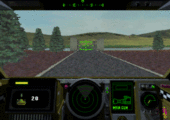
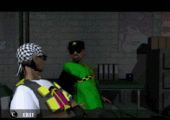
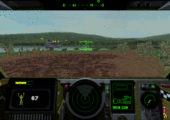
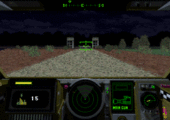
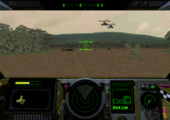
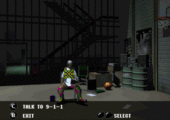
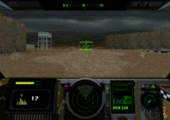
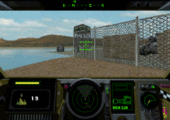
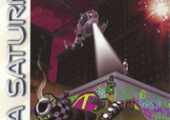
Recent Comments